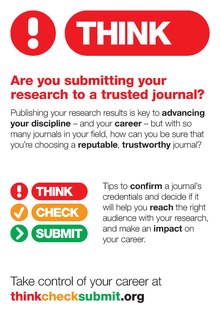
Predatory publishing, also write-only publishing[1][2] or deceptive publishing,[3] is an exploitative academic publishing business model, where the journal or publisher prioritizes self-interest at the expense of scholarship. It is characterized by misleading information, deviates from the standard peer-review process, is highly non-transparent, and often utilizes aggressive solicitation practices.[4]
The phenomenon of "open-access predatory publishers" was first noticed by Jeffrey Beall around 2012, when he described "publishers that are ready to publish any article for payment".[5] However, criticisms about the label "predatory" have been raised.[6] A lengthy review of the controversy started by Beall appears in The Journal of Academic Librarianship.[7]
Predatory publishers are so regarded because scholars are tricked into publishing with them, although some authors may be aware that the journal is poor quality or even fraudulent but publish in them anyway.[a] New scholars from developing countries are said to be especially at risk of being misled by predatory publishers.[9][10][11] A 2022 report found that "nearly a quarter of the respondents from 112 countries, and across all disciplines and career stages, indicated that they had either published in a predatory journal, participated in a predatory conference, or did not know if they had. The majority of those who did so unknowingly cited a lack of awareness of predatory practices; whereas the majority of those who did so knowingly cited the need to advance their careers."[12]
According to one study, 60% of articles published in predatory journals receive no citations over the five-year period following publication.[13][14]
Actors seeking to maintain the scholarly ecosystem have sought to minimize the influence of predatory publishing through the use of blacklists such as Beall's List and Cabell's blacklist, as well as through whitelists such as the Directory of Open Access Journals. Nevertheless, identifying (and even providing a quantitative definition) of predatory journals remains difficult, because it is a spectrum rather than a binary phenomenon.[15] In the same issue of a journal it is possible to find articles which meet the highest criteria for scientific integrity, and articles which have one or more unethical issues.
- ^ Bogost, Ian (24 November 2008). "Write-Only Publication".
- ^ Riehle, Dirk (13 September 2011). "Definition of Write-Only Journal".
- ^ Anderson, Rick (19 March 2019). "OSI Brief: Deceptive publishing".
- ^ Grudniewicz; et al. (11 December 2019). "Predatory journals: no definition, no defence". Nature. 576 (7786): 210–212. Bibcode:2019Natur.576..210G. doi:10.1038/d41586-019-03759-y. PMID 31827288.
- ^ Beall, Jeffrey (2012). "Predatory publishers are corrupting open access". Nature. 489 (7415): 179. Bibcode:2012Natur.489..179B. doi:10.1038/489179a. PMID 22972258. S2CID 659746.
- ^ Björk, Bo-Christer; Solomon, David (2012). "Open access versus subscription journals: A comparison of scientific impact". BMC Medicine. 10: 73. doi:10.1186/1741-7015-10-73. PMC 3398850. PMID 22805105.
- ^ Krawczyk, Franciszek; Kulczycki, Emanuel (2021). "How is open access accused of being predatory? The impact of Beall's lists of predatory journals on academic publishing". The Journal of Academic Librarianship. 47 (2): 102271. doi:10.1016/j.acalib.2020.102271. S2CID 228863095.
- ^ Kolata, Gina (30 October 2017). "Many Academics Are Eager to Publish in Worthless Journals" Archived 5 November 2017 at the Wayback Machine, The New York Times.
- ^ Kearney, Margaret H. (2015). "Predatory Publishing: What Authors Need to Know". Research in Nursing & Health. 38 (1): 1–3. doi:10.1002/nur.21640. PMID 25545343.
- ^ Xia, Jingfeng; Harmon, Jennifer L.; Connolly, Kevin G.; Donnelly, Ryan M.; Anderson, Mary R.; Howard, Heather A. (2014). "Who publishes in "predatory" journals?". Journal of the Association for Information Science and Technology. 66 (7): 1406–1417. doi:10.1002/asi.23265. hdl:1805/9740. S2CID 40929915.
- ^ Cite error: The named reference
whykurtwas invoked but never defined (see the help page). - ^ "Combatting Predatory Academic Journals and Conferences (Full Report in English)". 15 March 2022.
- ^ Brainard J (2020). "Articles in 'predatory' journals receive few or no citations". Science. 367 (6474): 129. Bibcode:2020Sci...367..129B. doi:10.1126/science.aba8116. PMID 31919198. S2CID 241194758.
- ^ Björk, Bo-Christer; Kanto-Karvonen, Sari; Harviainen, J. Tuomas (2020). "How Frequently are Articles in Predatory Open Access Journals Cited". Publications. 8 (2): 17. arXiv:1912.10228. doi:10.3390/publications8020017. S2CID 209444511.
- ^ "The guardians of Scopus".
Cite error: There are <ref group=lower-alpha> tags or {{efn}} templates on this page, but the references will not show without a {{reflist|group=lower-alpha}} template or {{notelist}} template (see the help page).